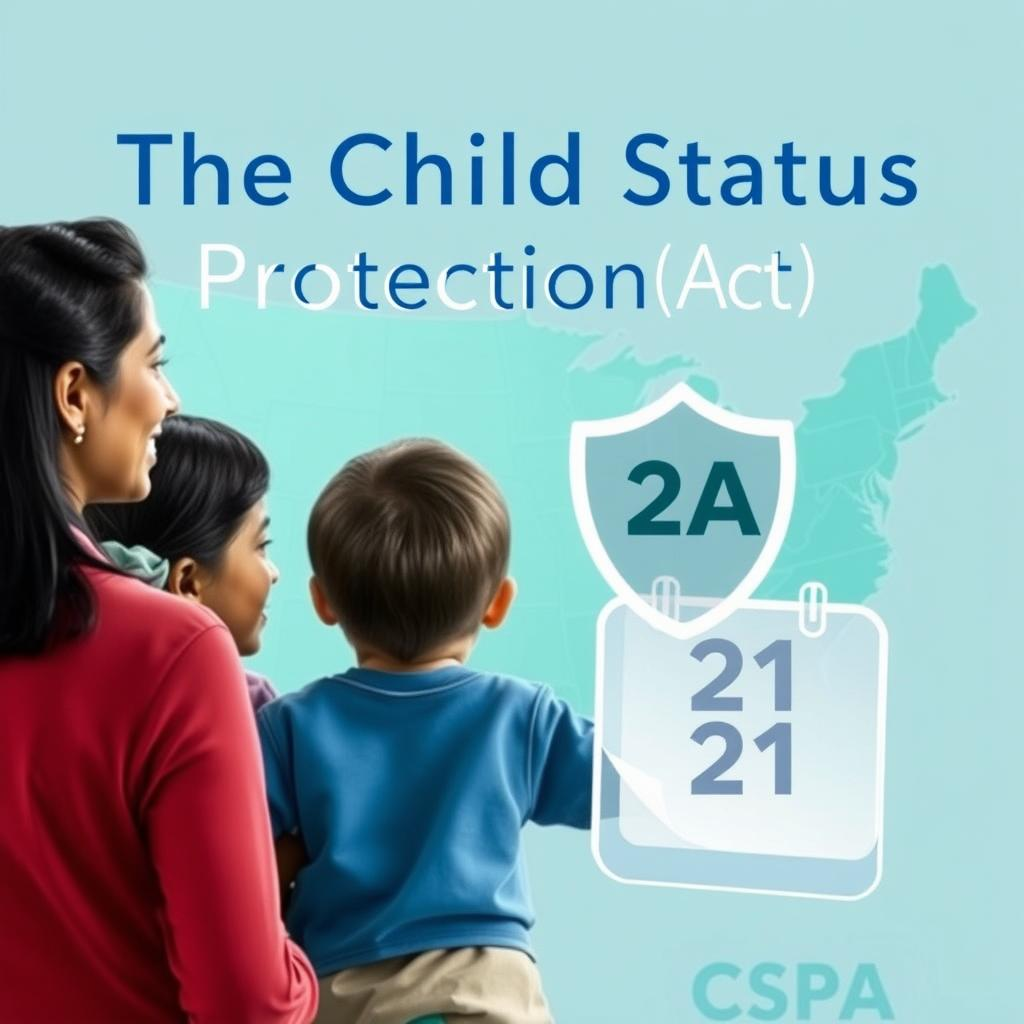The Child Status Protection Act (CSPA): Your Ultimate Guide to Preventing “Aging Out”
The journey through the U.S. immigration system is often a marathon, not a sprint. For families seeking to build a new life together in the United States, the years of waiting for a visa petition to be approved can be filled with both hope and anxiety. One of the most significant sources of stress is the fear of a child “aging out.”2 Imagine waiting a decade for your family’s green card, only to discover that your 20-year-old child, who was just 10 when you started the process, is about to turn 21 and may no longer qualify. This heartbreaking scenario was a harsh reality for many until the enactment of a crucial piece of legislation: the Child Status Protection Act (CSPA). This law acts as a vital safeguard, offering a mathematical lifeline to protect children from losing their eligibility due to lengthy government processing times.3
This comprehensive guide will demystify the CSPA, breaking down its complex rules into understandable concepts. We will explore who is protected, how the critical CSPA age is calculated, and the essential steps you must take to secure its benefits. Understanding this act is not just an academic exercise; it is a critical tool for families navigating the path to becoming lawful permanent residents of the United States.
What is the Child Status Protection Act (CSPA)?
The Child Status Protection Act (CSPA) is a U.S. federal law enacted on August 6, 2002, designed to protect certain foreign national children from losing their eligibility for an immigrant visa as a “child” simply because they turned 21 while waiting for the U.S. government to process their case.4 In the eyes of U.S. immigration law, a “child” is defined as someone who is unmarried and under the age of 21.5 Before CSPA, if an applicant turned 21 at any point before their visa or adjustment of status was approved, they “aged out,” often losing their place in line and facing many more years of separation from their family.6 USCIS CSPA rules provide a method to lock in a child’s age, preventing this devastating outcome.7
- Core Purpose: The primary goal of the CSPA is to prevent the aging out immigration crisis for a derivative beneficiary (a child or spouse who is included in a primary applicant’s visa petition).8 It addresses the issue of administrative delays that are beyond the applicant’s control.9
- Key Mechanism: The Act provides a specific mathematical formula to calculate a child’s “CSPA age,” which can be different from their biological age.10 If the CSPA age is under 21, the child retains their eligibility.11
- Applicability: CSPA protection extends across various immigrant categories, including petitions filed by U.S. citizens and Lawful Permanent Residents (LPRs) for their children, as well as children of employment-based and diversity visa applicants.
The Core Problem CSPA Solves: “Aging Out”
The U.S. immigration system is built on preference categories and strict definitions. The Immigration and Nationality Act (INA) gives preferential treatment to a “child” of a petitioner. When a child turns 21, they are no longer legally considered a “child” for these purposes. Thi12s transition can have drastic consequences, especially in the family preference categories where wait times can exceed a decade due to annual visa quotas.
- The Definition of a “Child”: According to the INA, a child is an individual who is unmarried and under 21 years of age.13 This definition is the cornerstone of eligibility for many family-based visas.
- Impact of Processing Delays: Immigrant visa petitions are handled by two main agencies: U.S. Citizenship and Immigration Services (USCIS) and the Department of State (DOS). Backlogs at either agency can significantly extend the time from filing the initial petition to the final visa interview, easily spanning several years.14
- Consequences of Aging Out: Before CSPA, when a child aged out, they would typically lose their place as a derivative beneficiary. For example, the unmarried under-21 child of an LPR is in the F-2A category. Upon turning 21, they would move to the F-2B category (unmarried sons and daughters over 21 of LPRs), which has a significantly longer wait time. The CSPA was created to remedy this fundamental unfairness.15
Who is Protected by the CSPA?
The Child Status Protection Act (CSPA) applies to a wide range of immigrant applicants, but the rules differ slightly depending on the specific visa category. It is essential to identify which category you fall into to understand how your child is protected.
- Immediate Relatives (IR) of U.S. Citizens: This category includes unmarried children under 21 of U.S. citizens. For these applicants, the child’s age is “frozen” on the date the U.S. citizen parent files the Form I-130, Petition for Alien Relative.16 As long as the child was under 21 at the time of filing and remains unmarried, they will not age out.17
- Family-Sponsored Preference Categories: This is where the CSPA calculation formula is most critical. It covers children in categories such as F-1, F-2A, F-2B, F-3, and F-4. The Act allows for the time the I-130 petition was pending with USCIS to be subtracted from the child’s age when a visa becomes available.18
- Employment-Based Preference Categories: Derivative children of principal applicants in employment-based immigration categories (e.g., EB-1, EB-2, EB-3) are also protected by the CSPA. The calculation works similarly to the family preference categories, subtracting the time the underlying immigrant petition (Form I-140) was pending.19
- Asylees and Refugees: The children of individuals granted asylum or refugee status are also eligible for CSPA protection. Their age is locked in on the date the principal applicant filed their asylum (Form I-589) or refugee application.
The CSPA Age Calculation Formula: How It Works
Understanding the CSPA age calculation formula is the key to determining eligibility. While it may seem intimidating, it can be broken down into a simple three-step process.
The Formula: CSPA Age = (Age of the child on the date a visa becomes available) – (Number of days the visa petition was pending)
Let’s break this down with a clear example.
Step 1: Determine the Child’s Age at Visa Availability
First, you need to find out when an immigrant visa is considered “available” for your category. This is the later of two dates:
- The date the visa petition (e.g., Form I-130) is approved.20
- The first day of the month that your priority date is current on the Final Action Dates chart of the Visa Bulletin published by the DOS.
Your priority date is typically the date USCIS received your initial petition.
Step 2: Calculate the Pending Petition Time
Next, calculate the number of days the visa petition was pending with USCIS. This is the period from the date USCIS received the petition (the receipt date) to the date it was approved (the approval date).21
Step 3: Subtract and Find the CSPA Age
Finally, subtract the pending time (Step 2) from the child’s age at visa availability (Step 1).22 The result is the child’s CSPA age.23 If this age is under 21, the child is protected.24
| Calculation Step | Example Scenario |
| Child’s Date of Birth | January 15, 2003 |
| I-130 Petition Filed (Priority Date) | March 1, 2013 |
| I-130 Petition Approved | May 1, 2018 |
| Visa Becomes Available (Priority Date is Current) | August 1, 2024 |
| 1. Child’s Age at Visa Availability | The child is 21 years, 6 months, and 17 days old on August 1, 2024. |
| 2. Pending Petition Time | From March 1, 2013, to May 1, 2018, is 5 years and 2 months. |
| 3. Calculate CSPA Age | (21 years, 6 months) – (5 years, 2 months) = 16 years, 4 months |
| Result | Because the child’s CSPA age is under 21, they are still eligible for the visa as a “child.” |
The “Sought to Acquire” Requirement: A Critical Step
Passing the CSPA age calculation is not enough. To lock in the protection, the applicant must satisfy another crucial condition: they must seek to acquire lawful permanent residence within one year of a visa becoming available. Failure to meet this strict one-year deadline will result in the loss of CSPA benefits, regardless of the calculated age.
- One-Year Deadline: This is a firm, non-negotiable deadline. It starts from the date the priority date becomes current on the Visa Bulletin and the petition is approved.
- Acceptable Actions: Taking one of the following steps is considered “seeking to acquire”:
- Properly filing Form I-485, Application to Register Permanent Residence or Adjust Status, if the applicant is in the U.S.
- Submitting the Form DS-260, Immigrant Visa Electronic Application, with the National Visa Center (NVC) for those processing at a consulate abroad.
- Paying the immigrant visa application fees to the NVC as part of consular processing.
- Consequences of Failure: If an applicant does not take one of these steps within the one-year window, they will permanently lose their CSPA eligibility for that petition.25 There are very limited exceptions to this rule, so timely action is paramount.
Navigating the CSPA Process and Your Immigration Journey
The rules surrounding the Child Status Protection Act (CSPA) are intricate. Calculating the CSPA age, tracking the Visa Bulletin, and meeting the “sought to acquire” deadline requires diligence and a clear understanding of the process. For families in India embarking on this journey, managing the extensive paperwork and procedural steps can be overwhelming.
This is where expert guidance can be invaluable. At AM Global, we specialize in assisting with complex documentation and visa processes. While we are based in Delhi, our services extend across India and overseas. We can help you organize your application, understand the requirements for a U.S. Visa, and ensure your documentation is in order. When your visa is finally approved, we can also assist with booking Flight Tickets for your family’s new beginning. If you need support navigating the documentation side of your U.S. immigration journey, contact us at +91-9999-422-422 or email amglobal.org@gmail.com.
Potential Pitfalls and Important Considerations
While the CSPA is a powerful tool, applicants should be aware of several other factors that can impact eligibility.
- The Marriage Bar: CSPA protection only applies to unmarried children.26 If a child marries at any point before becoming a lawful permanent resident, they will immediately lose eligibility under most “child” categories, and CSPA will no longer protect them.
- Automatic Conversion & Opt-Out: In certain situations where a Lawful Permanent Resident parent naturalizes to become a U.S. citizen, their child’s petition may automatically convert to a different category. The CSPA includes provisions allowing applicants to “opt-out” of this conversion if remaining in the original category is more beneficial (e.g., has a shorter wait time). This is a complex decision that requires careful analysis of the Visa Bulletin.
- Importance of Legal Counsel: The nuances of CSPA, especially in cases involving opt-out provisions or complex calculations, often require professional legal advice. Consulting with a qualified immigration attorney can provide clarity and ensure you are making the best decisions for your case. An attorney can offer personalized guidance that general service providers cannot.
- Precise Record-Keeping: Keep meticulous records of all correspondence from USCIS and the NVC. This includes receipt notices, approval notices, and fee bills. These documents contain the critical dates needed for the CSPA calculation formula and for proving you have met the “sought to acquire” requirement. For important document security, you may consider a reliable cloud storage service like Dropbox or Google One.
Frequently Asked Questions (FAQ)
1. What happens if my calculated CSPA age is over 21?
If the result of the CSPA calculation formula is 21 or over, unfortunately, you do not qualify for CSPA protection under that petition.29 You would be considered “aged out” and would be moved to the applicable adult category (e.g., F-2B for the over-21 unmarried child of an LPR), which typically involves a much longer waiting period.30
2. Does getting married affect my CSPA eligibility?
Yes, absolutely. To be considered a “child” or a derivative beneficiary child under most family and employment-based categories, you must remain unmarried.31 If you marry at any point before you are granted lawful permanent residence (i.e., receive your green card), you will lose your eligibility, and CSPA will no longer apply.
3. Is CSPA protection automatic?
No, it is not entirely automatic. While the age calculation is a right under the law, you must take an affirmative step to lock in the protection.32 You must meet the “sought to acquire” requirement by filing the appropriate application (like Form I-485 or DS-260) or paying visa fees within one year of your visa becoming available.33 If you fail to do this, you lose the protection.
4. How do I know when my visa is available?
A visa is considered available when your priority date is earlier than the date listed for your category in the “Final Action Dates” chart of the monthly Visa Bulletin.34 You must check the official Visa Bulletin published by the U.S. Department of State every month.35
5. Can I use CSPA for a nonimmigrant visa like a student visa (F-1) or tourist visa (B-2)?
No. The Child Status Protection Act (CSPA) applies only to immigrant visas (green cards). It does not apply to nonimmigrant visa categories like student, tourist, or temporary work visas.
Conclusion
The Child Status Protection Act (CSPA) stands as a beacon of hope for thousands of families, ensuring that the dream of U.S. residency is not shattered by bureaucratic delays. It provides a logical and fair solution to the problem of aging out immigration, allowing children to remain with their families.27 However, its protection is not automatic. Applicants must be proactive—they must understand the CSPA age calculation, vigilantly monitor their priority date in the Visa Bulletin, and, most importantly, seek to acquire lawful permanent residence within the strict one-year window.28 By arming yourself with this knowledge, you can confidently navigate the final stages of your immigration journey and keep your family together.
Disclaimer: The information provided in this article is for general informational purposes only and does not constitute legal advice. Immigration laws and policies are complex and change frequently. You should consult with a qualified immigration attorney for advice regarding your individual situation.
Affiliate Disclosure: This article may contain affiliate links. If you use these links to buy something, we may earn a commission at no extra cost to you. This helps support our efforts to provide valuable content.







